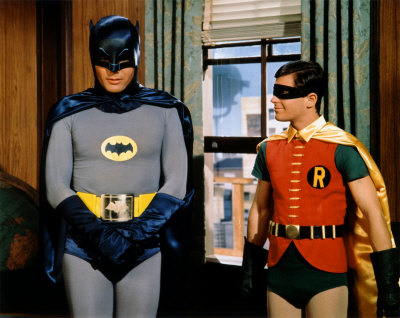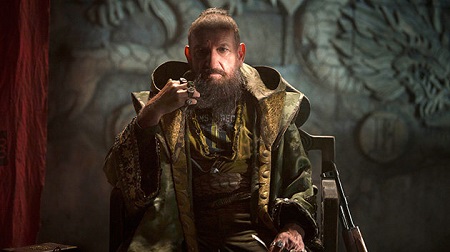Gay Panics And Crowbars: Whatever Happened To Robin?
At first they were inseparable, but a series of PR disasters and criticism from outspoken fans has left the Boy Wonder in the shadows of his partner.

He’s one of fictions most famous sidekicks, up there with Dr. Watson, Chewbacca and Tonto (the Mohawk one, not the white guy one). But despite this, DC Comics’ Robin has become a pariah to many comic book readers and a walking punch line to everyone else. If he’s not being derided as a danger to Batman’s ‘grim & gritty’ credentials, he’s the target of endless innuendo and homophobic one-liners. In recent years the character has been increasingly excised from the Batman mythos and has not been seen in film of TV for almost a decade. But how did a character as much a part of The Caped Crusader as Alfred and the Batmobile, and who largely invented the sidekick in its modern form, devolve into a cliché for hackneyed comedy writers.
With title and costume inspired by the legend of Robin Hood, the original Robin (Dick Grayson) first appeared in Detective Comics #38, released in April 1940 almost one year after Batman’s debut. It was with the introduction of “The Boy Wonder” that Batman took the form recognisable across the world today. In his first year of publication The Dark Knight had been little more than a knock-off of The Shadow who carried guns, killed his enemies and fought racist “yellow peril” stereotypes. It was with Robin at his side that he transitioned into the more colourful character known today, with belt full of wacky gadgets in the place of twin automatics. The following years saw the introduction of faithful butler Alfred, arch-nemesis The Joker and even Ace The Bat-Hound. But after nearly 15 years of fighting evil and becoming one of National Publications’ (the future DC Comics) biggest sellers, the dynamic duo would meet one of their greatest ever enemies. A psychiatrist from New York.
In 1954 German-American psychiatrist Dr. Fredric Wertham published The Seduction of the Innocent, a study that cited comic books as the source of the country’s growing juvenile delinquency problem. Wertham observed patterns of sadistic violence, rampant sexualisation and occultism throughout comics and particularly in the then popular horror comics such as Tales from the Crypt. But between the analysis of severed heads, melted eyeballs and half naked women were a mere two paragraphs on the subject of Batman & Robin, who he described as “a wish dream of two homosexuals living together.” If any queer readings of the characters existed before, Wertham’s work had catapulted them into the mainstream. In the years following, characters such as Batwoman would be introduced in an effort to quell audience suspicions, but the accusations would hang over the characters like a dark cloud for decades to come.
Despite this bump in the road Batman & Robin continued to be some of DC Comics’ most popular characters. The 1966 Adam West TV series would raise the duo to mega stardom, with a high camp aesthetic that almost buried the old accusations under a mountain of self-awareness. But by the 1980’s the tide was turning. Even before the Anime/Manga book of the 1990’s, American comics companies were struggling to maintain young audiences and a new generation of adult fans were quickly becoming the industry’s biggest cash cows. In the wake of such mature titles as Alan Moore’s Watchmen and Frank Millar’s The Dark Knight Returns, comics were injected with enough breast, guns and dismemberments to appease the anxieties of fans consuming what was still seen as a children’s genre. And while a hook hand was considered enough to update Aquaman, Batman was going to need a more considerable appendage removed. Robin had to go.
In 1988, following the result of a call-in vote, the by then second Robin Jason Todd was killed off. Beaten to death with a crowbar in true 80’s comic style. Batman had become a hyper masculine icon for a generation of mouth breathing beta-males while in contrast Robin was an antichrist, a multi-coloured skeleton in Batman’s closet that many would gladly see expunged forever. While Tim Drake would soon be introduced as Robin III, a wedge was driven between the by then 50 year old duo.
More…
More comics would see Batman going it alone on Gotham’s roof tops and alleyways, while Robin spent most of his time captaining The Teen Titans. But while the anti-Robin camp had become the most vocal in comic fandom, for the general public Batman & Robin still went together like apple pie and ice-cream. Until 1997 when Joel Schumacher’s Batman & Robin would become the biggest PR disaster since Wertham’s original accusation. With its cartoon aesthetic, drag queen Poison Ivy and rubber nipples the film would turn a long-standing joke into a full-blown gay panic. The film was quickly labelled one worst of all time and a great deal of homophobic language was aimed at director Joel Schumacher, an openly gay man who was seen as having corrupted the character. But while Batman & Robin does possess decidedly queer sensibilities, nothing in Schumacher’s film was out of keeping with the camp tone of the 70’s comics or the Adam West series that most audiences were familiar with. The backlash was not the outcry of truly devoted fans, but of a particular group of fans that saw their version of Batman as under attack.
Regardless of its source this anxiety has stuck and the last seventeen years have seen Robin all but absent. In the comics Bruce Wayne’s son Damian briefly took the mantle only to again be killed off (stabbed to death this time) and no film or TV series has placed the characters side by side since 2008. The most recent series, Beware the Batman, instead replaced Robin with female sidekick Katana, a DC D-lister who brought nothing to a show cancelled before the end of even it’s first season. And save for a pointless joke in its final scene, Robin had no place in Christopher Nolan’s blockbuster trilogy.
With Damian dead and all the surviving Robins relegated to new identities there is no Robin in the DC’s “New 52” line of comics, a rebrand that has been seen by many as a return to some of the worst excesses of the 1980’s. In his absence Batman comics have become more violent than at any point in his history. While that first year may have been full of bodies and bullets, it didn’t feature nearly as many face stealing serial killers and PCP addicted psychopaths. At this point the character is all but inaccessible to young readers, with most new issues as appropriate for a 12-year-old as a Saw box set. It is unclear at this point when the Dynamic Duo will be seen together again or if Batman can shake of the brutal tone he has developed in his absence.
It’s unlikely the upcoming Batman v Superman from Zack Snyder will change anything, coming from the director who managed to transform the Man of Tomorrow into a brooding and nihilistic mess of neck snapping and 9/11 imagery. The fans fixated on a “grim and gritty” Batman have not disappeared either and have in fact grown in the aftermath of Christopher Nolan’s decidedly joyless trilogy. Will The Boy Wonder return, will a new generation of children be introduced to comics, will Batman lighten the hell up. Only time and maybe another DC marketing stunt will tell.
If you like it, Pass it on
 COMMENTS
COMMENTS
No comments yet, be the first!


 RELATED
RELATED



 SABOTAGE
SABOTAGE





